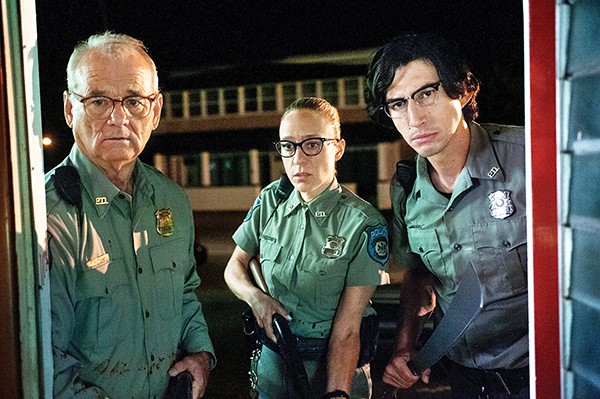The town of Centerville’s welcome sign says it all: “A Real Nice Place.” Police chief Cliff Robertson (Bill Murray) and officer Ronnie Peterson (Adam Driver) don’t have to work too hard to keep the peace. When The Dead Don’t Die opens, they’re checking out a report by Farmer Miller (Steve Buscemi) that old Hermit Bob (Tom Waits) has been stealing his chickens. The investigation goes pretty much nowhere, because Chief Robertson thinks Farmer Miller’s an asshole, and all Hermit Bob will say is “fuck you.”
As they head back to the station, Cliff and Ronnie notice that there’s something weird going on. This is, of course, the set up to nearly every zombie film ever made: Two people, their heads buried in the daily minutiae, slowly come to realize that their world is being overrun by the unquiet dead.
You probably don’t associate director Jim Jarmusch with the genre, but he has obviously seen a few zombie movies in his time. Jarmusch’s primary directing mode has always been that of the observer. He favors letting things play out in long takes, the better to get to know his characters, warts and all. His 1989 masterpiece Mystery Train, which immortalized the down-and-out Memphis of the era, lingered on the bewildered faces of Jun and Mitsuko, the Japanese tourists who were discovering the real America. In Night on Earth, he got a career best performance from Winona Ryder by simply riding around in a cab with her.

(l to r) Bill Murray, Chloë Sevigny, and Adam Driver star in Jim Jarmusch’s The Dead Don’t Die.
But he’s also always had a taste for genre pictures, such as his 1995 Western Dead Man, where he shot Johnny Depp in creamy duotone while demolishing the genre’s black and white morality plays. His last foray into supernatural horror was 2014’s transcendent Only Lovers Left Alive, where Tilda Swinton and Tom Hiddleston played centuries-old vampires feeling the weight of immortality.
As one of the godfathers of independent film, Jarmusch knows how to get a project done by rounding up all of your friends and showing them a good time while they work. The difference with Jarmusch is the quality of the friends’ talents. Sara Driver, who became his partner while he was making his first film Stranger Than Paradise, appears as a zombie. Steve Buscemi, who here sports a “Keep America White Again” hat, rode with Joe Strummer in Mystery Train. Tom Waits spouted gruff wisdom in Coffee and Cigarettes. Bill Murray was the lead of Jarmusch’s 2005 film Broken Flowers. The director worked with Iggy Pop for years to make a documentary on The Stooges. Tilda Swinton, so chillingly elegant in Only Lovers Left Alive, appears in The Dead Don’t Die as an eccentric coroner who is aces with a samurai sword. Adam Driver was magnificent in Paterson, Jarmusch’s last film. The list goes on.
Murray and Driver, joined by Chloë Sevigny as Officer Mindy, first try to make sense out of the dead rising from the grave with a hunger for human flesh, then try to contain the zombie contagion. They also serve as their own Greek chorus, commenting on the action as it happens around and to them, delivering sly in-jokes, and making the occasional meta foray. There are references to earlier Jarmusch films, such as the road-tripping tourists, played by Selena Gomez, Luka Sabbat, and Austin Butler (slicked up like Strummer), who pick the wrong time to hole up in a seedy room at the Moonlight Motel. Jarmusch, the consummate indie film hipster, gets a laugh at their — and his own — expense with the line “Infernal hipsters and their irony!”
In the tradition of George Romero, who invented and perfected the modern zombie picture, Jarmusch uses the walking dead as satirical mirrors of society. Like the ghouls in Dawn of the Dead, they are drawn to the things they coveted in life, only in this case it’s wifi and chardonnay.
As a zombie comedy, The Dead Don’t Die never reaches the manic heights of Shaun of the Dead; but then again, it never tries that approach. Jarmuch’s sense of humor is dry as a bone, and his pacing deliberate. Hermit Bob, who watches the zombie apocalypse gather strength through cracked binoculars, serves as the director’s alter ego. He can’t fully participate in the rapidly decaying human society, but he can’t look away, either. One line in particular from The Dead Don’t Die seems designed to resonate through Jarmusch’s entire filmmaking career: “The world is perfect. Appreciate the details.”
The Dead Don’t Die